Ortiz de Montellano Paul R.(Ed.) Cytochrome P450. Structure, Mechanism, and Biochemistry
Подождите немного. Документ загружается.

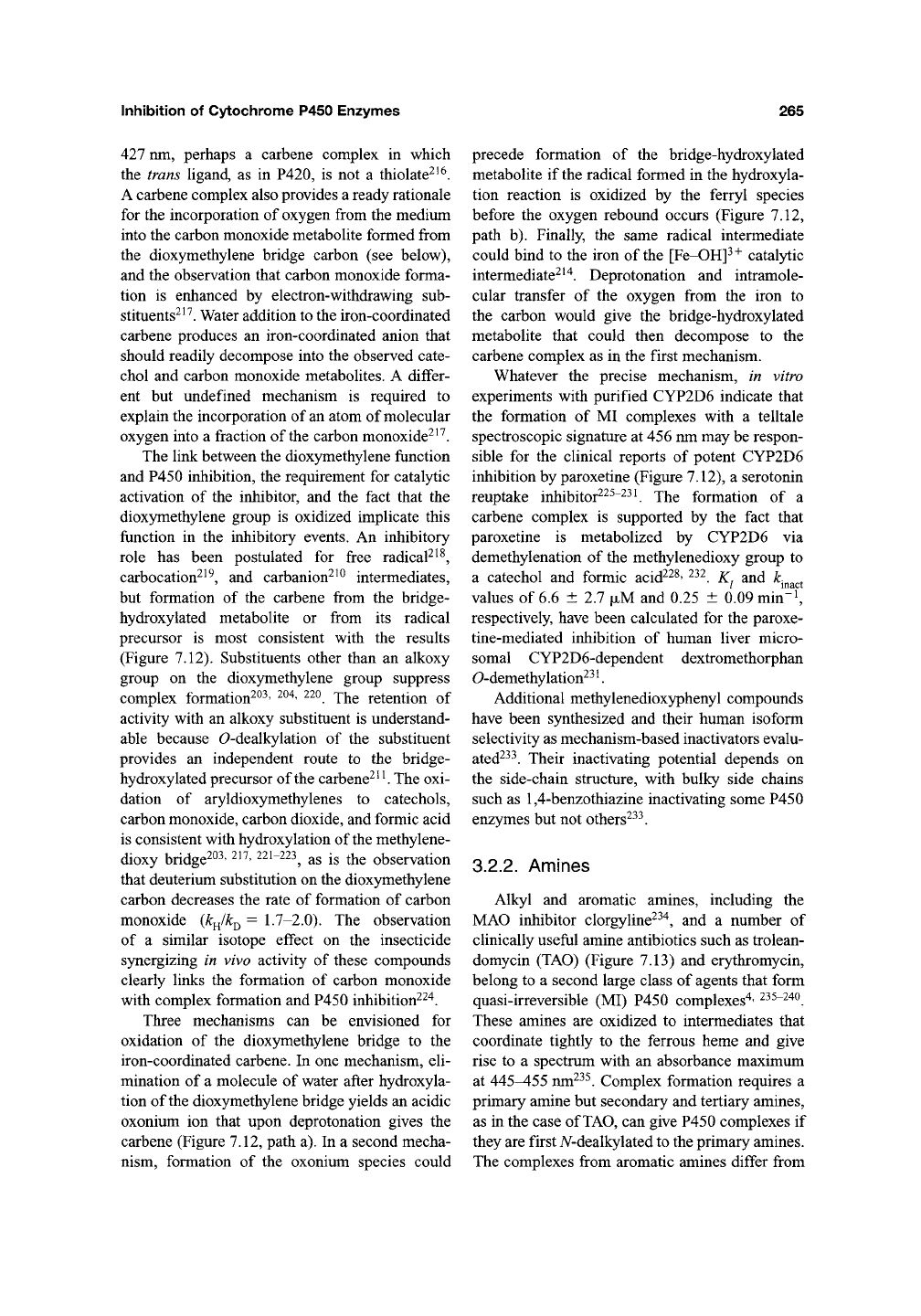
Inhibition of Cytochrome P450 Enzymes
265
427 nm, perhaps a carbene complex in which
the trans hgand, as in P420, is not a thiolate^^^.
A carbene complex also provides a ready rationale
for the incorporation of oxygen from the medium
into the carbon monoxide metabolite formed from
the dioxymethylene bridge carbon (see below),
and the observation that carbon monoxide forma-
tion is enhanced by electron-withdrawing sub-
stituents^^^. Water addition to the iron-coordinated
carbene produces an iron-coordinated anion that
should readily decompose into the observed cate-
chol and carbon monoxide metabolites. A differ-
ent but undefined mechanism is required to
explain the incorporation of an atom of molecular
oxygen into a fraction of
the
carbon monoxide^ ^'^.
The link between the dioxymethylene function
and P450 inhibition, the requirement for catalytic
activation of the inhibitor, and the fact that the
dioxymethylene group is oxidized implicate this
function in the inhibitory events. An inhibitory
role has been postulated for free radical^ ^^,
carbocation^^^, and carbanion^^^ intermediates,
but formation of the carbene from the bridge-
hydroxylated metabolite or from its radical
precursor is most consistent with the results
(Figure 7.12). Substituents other than an alkoxy
group on the dioxymethylene group suppress
complex formation^^^' ^^'^' ^^°. The retention of
activity with an alkoxy substituent is understand-
able because O-dealkylation of the substituent
provides an independent route to the bridge-
hydroxylated precursor of the carbene^ ^^ The oxi-
dation of aryldioxymethylenes to catechols,
carbon monoxide, carbon dioxide, and formic acid
is consistent with hydroxylation of the methylene-
dioxy bridge^^^' ^^^'
221-223^
^g jg ^^ observation
that deuterium substitution on the dioxymethylene
carbon decreases the rate of formation of carbon
monoxide
{k^k^^
=
1.7-2.0).
The observation
of a similar isotope effect on the insecticide
synergizing in vivo activity of these compounds
clearly links the formation of carbon monoxide
with complex formation and P450 inhibition^^^.
Three mechanisms can be envisioned for
oxidation of the dioxymethylene bridge to the
iron-coordinated carbene. In one mechanism, eli-
mination of a molecule of water after hydroxyla-
tion of the dioxymethylene bridge yields an acidic
oxonium ion that upon deprotonation gives the
carbene (Figure 7.12, path a). In a second mecha-
nism, formation of the oxonium species could
precede formation of the bridge-hydroxylated
metabolite if the radical formed in the hydroxyla-
tion reaction is oxidized by the ferryl species
before the oxygen rebound occurs (Figure 7.12,
path b). Finally, the same radical intermediate
could bind to the iron of the [Fe-OH]^+ catalytic
intermediate^ ^'^. Deprotonation and intramole-
cular transfer of the oxygen from the iron to
the carbon would give the bridge-hydroxylated
metabolite that could then decompose to the
carbene complex as in the first mechanism.
Whatever the precise mechanism, in vitro
experiments with purified CYP2D6 indicate that
the formation of MI complexes with a telltale
spectroscopic signature at 456 nm may be respon-
sible for the clinical reports of potent CYP2D6
inhibition by paroxetine (Figure 7.12), a serotonin
reuptake inhibitor^^^"^^^. The formation of a
carbene complex is supported by the fact that
paroxetine is metabolized by CYP2D6 via
demethylenation of the methylenedioxy group to
a catechol and formic acid^^^' ^^^. Kj and A:.^^^^
values of 6.6 ± 2.7
|JLM
and 0.25 ± 0.09 min"^
respectively, have been calculated for the paroxe-
tine-mediated inhibition of human liver micro-
somal CYP2D6-dependent dextromethorphan
0-demethylation^^ ^.
Additional methylenedioxyphenyl compounds
have been synthesized and their human isoform
selectivity as mechanism-based inactivators evalu-
ated^^ ^. Their inactivating potential depends on
the side-chain structure, with bulky side chains
such as 1,4-benzothiazine inactivating some P450
enzymes but not others^^^.
3.2.2. Amines
Alkyl and aromatic amines, including the
MAO inhibitor clorgyline^^"^, and a number of
clinically usefiil amine antibiotics such as trolean-
domycin (TAO) (Figure 7.13) and erythromycin,
belong to a second large class of agents that form
quasi-irreversible (MI) P450 complexes^' 235-240
These amines are oxidized to intermediates that
coordinate tightly to the ferrous heme and give
rise to a spectrum with an absorbance maximum
at 445-455 nm^^^. Complex formation requires a
primary amine but secondary and tertiary amines,
as in the case of
TAO,
can give P450 complexes if
they are first iV-dealkylated to the primary amines.
The complexes from aromatic amines differ from
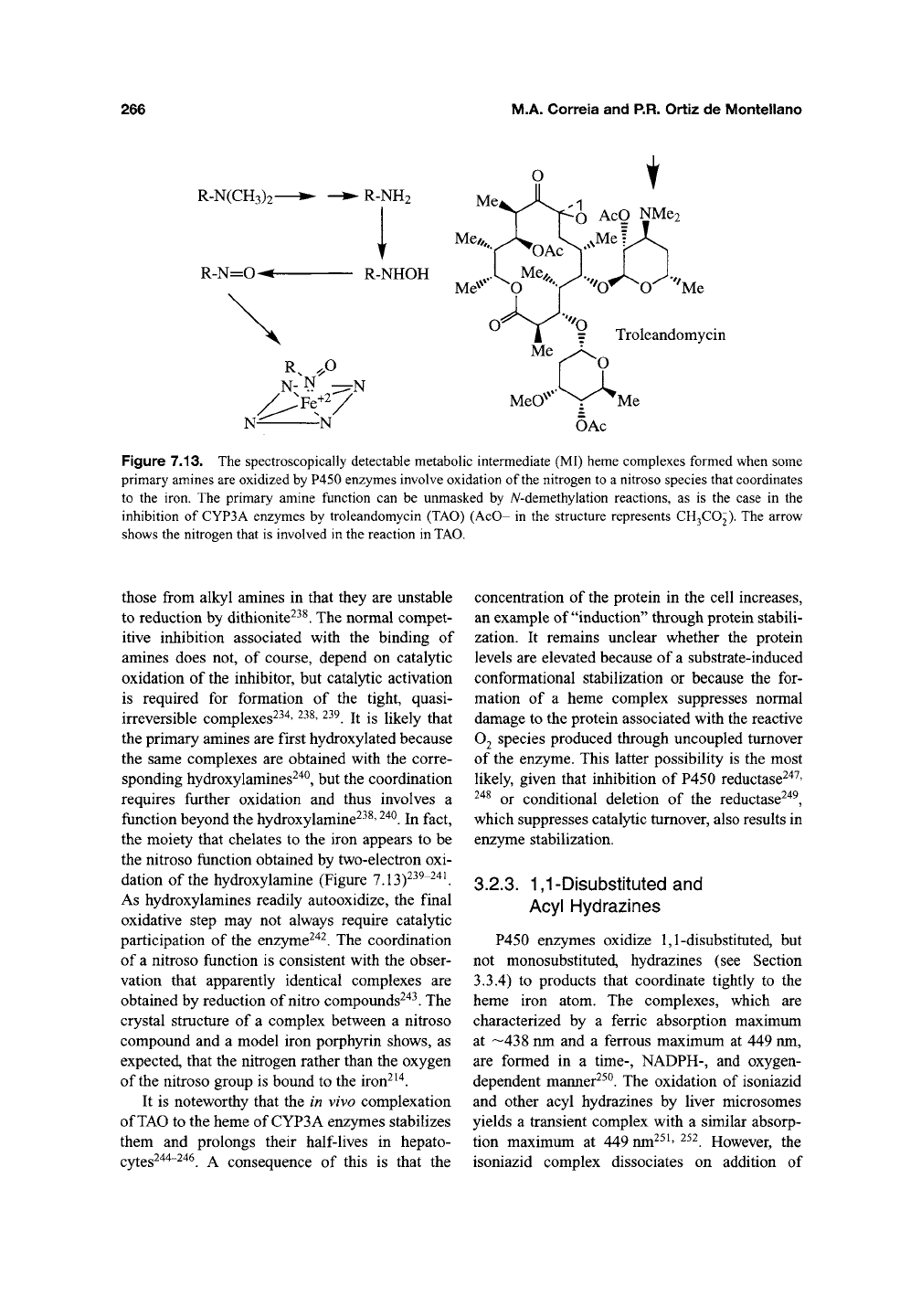
266
M.A. Correia and P.R. Ortiz de Montellano
R-N(CH3)2-
R-N=0-
R-NH2
R-NHOH
O AcO NMe2
Me?
N-N —N
t
"'0*^0'"'''Me
Troleandomycin
OAc
Figure 7.13. The spectroscopically detectable metabolic intermediate (MI) heme complexes formed when some
primary amines are oxidized by P450 enzymes involve oxidation of the nitrogen to a nitroso species that coordinates
to the iron. The primary amine function can be unmasked by A^-demethylation reactions, as is the case in the
inhibition of CYP3A enzymes by troleandomycin (TAO) (AcO- in the structure represents CH3CO2). The arrow
shows the nitrogen that is involved in the reaction in TAO.
those from alkyl amines in that they are unstable
to reduction by dithionite^^^. The normal compet-
itive inhibition associated with the binding of
amines does not, of course, depend on catalytic
oxidation of the inhibitor, but catalytic activation
is required for formation of the tight, quasi-
irreversible complexes^^"*' ^^^' ^^^. It is likely that
the primary amines are first hydroxylated because
the same complexes are obtained with the corre-
sponding hydroxylamines^"^^, but the coordination
requires further oxidation and thus involves a
function beyond the hydroxylamine^^^'
•^^^.
In fact,
the moiety that chelates to the iron appears to be
the nitroso function obtained by two-electron oxi-
dation of the hydroxylamine (Figure 7.13)^^^"^'^^
As hydroxylamines readily autooxidize, the final
oxidative step may not always require catalytic
participation of the enzyme^^^. The coordination
of a nitroso function is consistent with the obser-
vation that apparently identical complexes are
obtained by reduction of nitro compounds^"^^. The
crystal structure of a complex between a nitroso
compound and a model iron porphyrin shows, as
expected, that the nitrogen rather than the oxygen
of
the
nitroso group is bound to the iron^^"^.
It is noteworthy that the in vivo complexation
of TAO to the heme of CYP3A enzymes stabilizes
them and prolongs their half-lives in hepato-
cytes^
^. A consequence of this is that the
concentration of the protein in the cell increases,
an example of "induction" through protein stabili-
zation. It remains unclear whether the protein
levels are elevated because of a substrate-induced
conformational stabilization or because the for-
mation of a heme complex suppresses normal
damage to the protein associated with the reactive
O2 species produced through uncoupled turnover
of the enzyme. This latter possibility is the most
likely, given that inhibition of P450 reductase^"^^'
•^^^
or conditional deletion of the reductase^"*^,
which suppresses catalytic turnover, also results in
enzyme stabilization.
3.2.3. 1,1-Disubstituted and
Acyl Hydrazines
P450 enzymes oxidize 1,1-disubstituted, but
not monosubstituted, hydrazines (see Section
3.3.4) to products that coordinate tightly to the
heme iron atom. The complexes, which are
characterized by a ferric absorption maximum
at ~438 nm and a ferrous maximum at 449 nm,
are formed in a time-, NADPH-, and oxygen-
dependent manner^^^. The oxidation of isoniazid
and other acyl hydrazines by liver microsomes
yields a transient complex with a similar absorp-
tion maximum at 449 nm^^^' ^^^. However, the
isoniazid complex dissociates on addition of
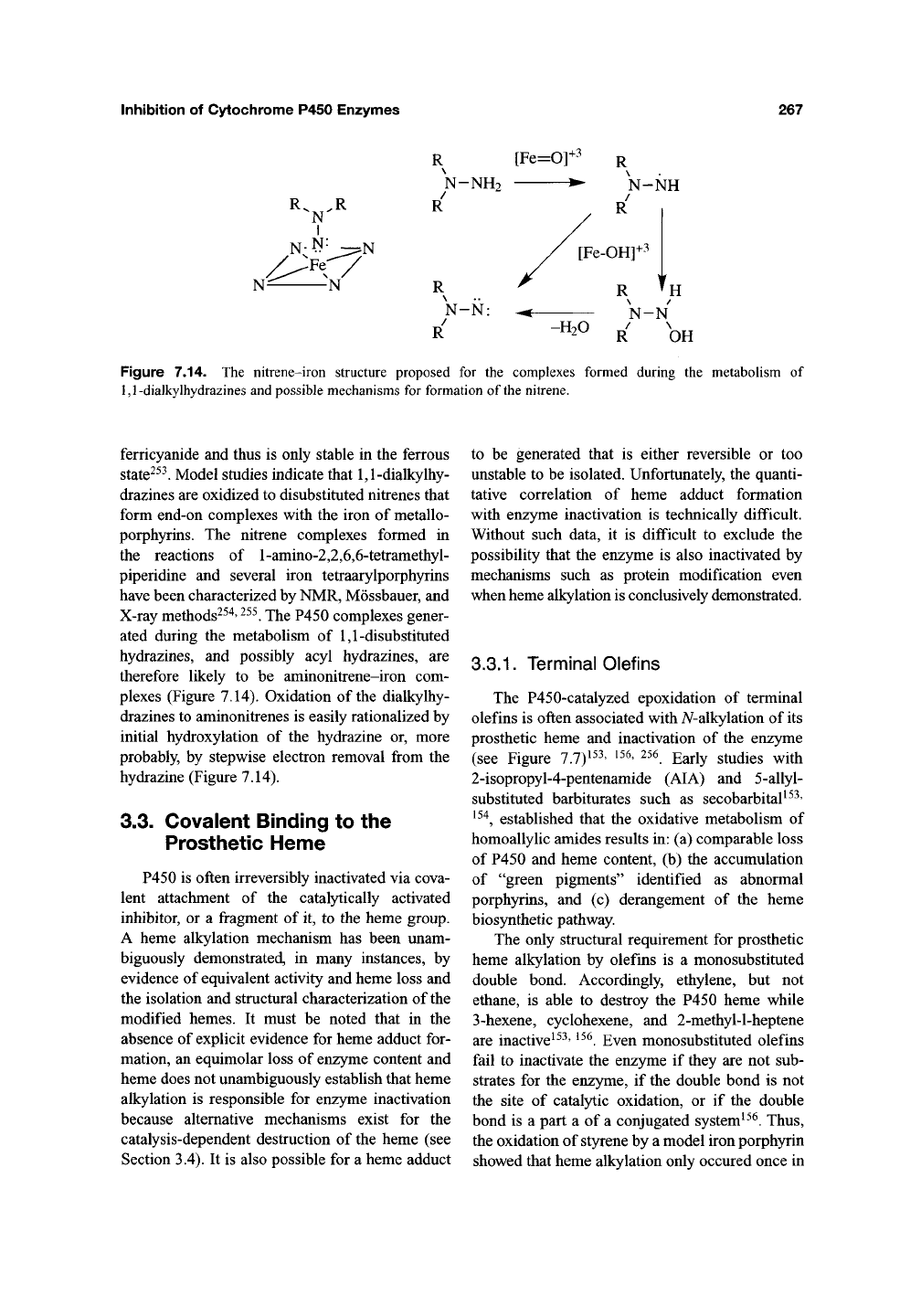
Inhibition of Cytochrome P450 Enzymes
267
R
[Fe=0]^
R
N-NH2
N-NH
R
[Fe-OH]
R
+3
H
N-N:
R
-H2O
N-N
/ \
R OH
Figure 7.14. The nitrene-iron structure proposed for the complexes formed during the metaboHsm of
1,1-dialkylhydrazines and possible mechanisms for formation of the nitrene.
ferricyanide and thus is only stable in the ferrous
state^^^.
Model studies indicate that 1,1-dialkylhy-
drazines are oxidized to disubstituted nitrenes that
form end-on complexes with the iron of metallo-
porphyrins. The nitrene complexes formed in
the reactions of l-amino-2,2,6,6-tetramethyl-
piperidine and several iron tetraarylporphyrins
have been characterized by NMR, Mossbauer, and
X-ray methods^^^'
^^^.
The P450 complexes gener-
ated during the metabolism of 1,1-disubstituted
hydrazines, and possibly acyl hydrazines, are
therefore likely to be aminonitrene-iron com-
plexes (Figure 7.14). Oxidation of the dialkylhy-
drazines to aminonitrenes is easily rationalized by
initial hydroxylation of the hydrazine or, more
probably, by stepwise electron removal from the
hydrazine (Figure 7.14).
3.3. Covalent Binding to the
Prosthetic Heme
P450 is often irreversibly inactivated via cova-
lent attachment of the catalytically activated
inhibitor, or a fragment of it, to the heme group.
A heme alkylation mechanism has been unam-
biguously demonstrated, in many instances, by
evidence of equivalent activity and heme loss and
the isolation and structural characterization of the
modified hemes. It must be noted that in the
absence of explicit evidence for heme adduct for-
mation, an equimolar loss of enzyme content and
heme does not unambiguously establish that heme
alkylation is responsible for enzyme inactivation
because alternative mechanisms exist for the
catalysis-dependent destruction of the heme (see
Section 3.4). It is also possible for a heme adduct
to be generated that is either reversible or too
unstable to be isolated. Unfortunately, the quanti-
tative correlation of heme adduct formation
with enzyme inactivation is technically difficult.
Without such data, it is difficult to exclude the
possibility that the enzyme is also inactivated by
mechanisms such as protein modification even
when heme alkylation is conclusively demonstrated.
3.3.1.
Terminal Olefins
The P450-catalyzed epoxidation of terminal
olefins is often associated with iV-alkylation of its
prosthetic heme and inactivation of the enzyme
(see Figure 7.7)^^^' 1^^' ^^^. Early studies with
2-isopropyl-4-pentenamide (AIA) and 5-allyl-
substituted barbiturates such as secobarbital^^^'
^^^,
established that the oxidative metabolism of
homoallylic amides results in: (a) comparable loss
of P450 and heme content, (b) the accumulation
of "green pigments" identified as abnormal
porphyrins, and (c) derangement of the heme
biosynthetic pathway.
The only structural requirement for prosthetic
heme alkylation by olefins is a monosubstituted
double bond. Accordingly, ethylene, but not
ethane, is able to destroy the P450 heme while
3-hexene, cyclohexene, and 2-methyl-l-heptene
are inactive^^^' ^^^. Even monosubstituted olefins
fail to inactivate the enzyme if they are not sub-
strates for the enzyme, if the double bond is not
the site of catalytic oxidation, or if the double
bond is a part a of a conjugated system^^^. Thus,
the oxidation of styrene by a model iron porphyrin
showed that heme alkylation only occured once in

268
M.A. Correia and P.R. Ortiz de Montellano
ten thousand turnovers^^^, in contrast to the ratio
of less than 300 turnovers per alkylation even
that is commonly observed with unconjugated ter-
minal olefins^. These observations suggest that
alkylation of
the
heme by olefins is compromised
by steric constraints and/or by the presence of
substituents that can delocalize charge or electron
density from the double bond.
Spectroscopic methods have unambiguously
established the structures of A^-alkylated porphyrins
isolated from the livers of rats treated with diverse
olefins, including ethylene, propene, octene,
fluroxene, 2,2-diethyl-4-pentenamide, 2-isopropyl-
4-pentenamide, and vinyl fluoride'^' 257-26O
Analogous products are probably formed in the
inactivation of P450 by other olefins, such as in the
inactivation of CYP2E1 by the garlic components
diallyl sulfide and diallylsulfone26i-264^ but the
resulting adducts have not been isolated. The
terminal carbon of the double bond is bound to a
porphyrin nitrogen and the internal carbon of
the olefin bears a hydroxyl group in the structures
of all the olefin adducts determined so far
(Figures 7.7 and 7.15'^^*'
^58^
jj^g oxygen in the
ethylene and 2-isopropyl-4-pentenamide adducts,
which has been shown by '^O studies to derive
from molecular oxygen, is presumed to be the cat-
alytically activated oxygen^^^'
^^^.
The structure of
the adduct is consistent with addition of the
porphyrin nitrogen to the epoxide metabolite of
the olefin, but this possibility is precluded by the
following findings: (a) the enzyme is refractory to
inactivation by the epoxides of olefins that destroy
the enzyme ^^^'
^^^' ^^^,
(b) c/^-addition of the nitro-
gen and oxygen to the double bond is inconsistent
with the trans sterochemistry expected for the
addition of a nucleophile to an epoxide^^^, (c) the
nitrogen reacts with the terminal rather than inter-
nal carbon of vinyl ethers although the internal
(oxygen-substituted) carbon is more reactive in
the corresponding epoxides^^^, and (d) the pyrrole
nitrogens are weak nucleophiles and do not react
with epoxides even under harsh chemical condi-
tions.
These considerations and the requirement
for enzyme turnover indicate that catalytic oxygen
transfer to the double bond initiates enzyme inac-
tivation but it does not result from reaction with
the epoxide metabolite.
Ethylene, propene, and octene, all linear
olefins, only detectably alkylate pyrrole ring D
of the prosthetic heme of the phenobarbital-
inducible rat liver P450 enzymes (Figure 7.15),
but heme alkylation by the more "globular"
olefins 2-isopropyl-4-pentenamide and 2,2-
diethyl-4-pentenamide is less regiospecific^^^'
^^^.
The regiochemistry and stereochemistry of heme
alkylation by ^ra«5-[l-^H]-l-octene has estab-
lished that the olefin stereochemistry is preserved
P450
P450
HO^
H
Figure 7.15. The oxidation of ^ra«5-l-[l-^H]octene by rat liver microsomes yields both the epoxide metabolite
and the indicated A^-alkyl heme adduct, the structure of which has been unambiguously established. The heme
substituents
are:
Me=CH3,
V=CH=CH2, P=CH2CH2C02H. The peripheral pyrrole carbons and the
meso
carbons
of
the
porphyrin are labeled.
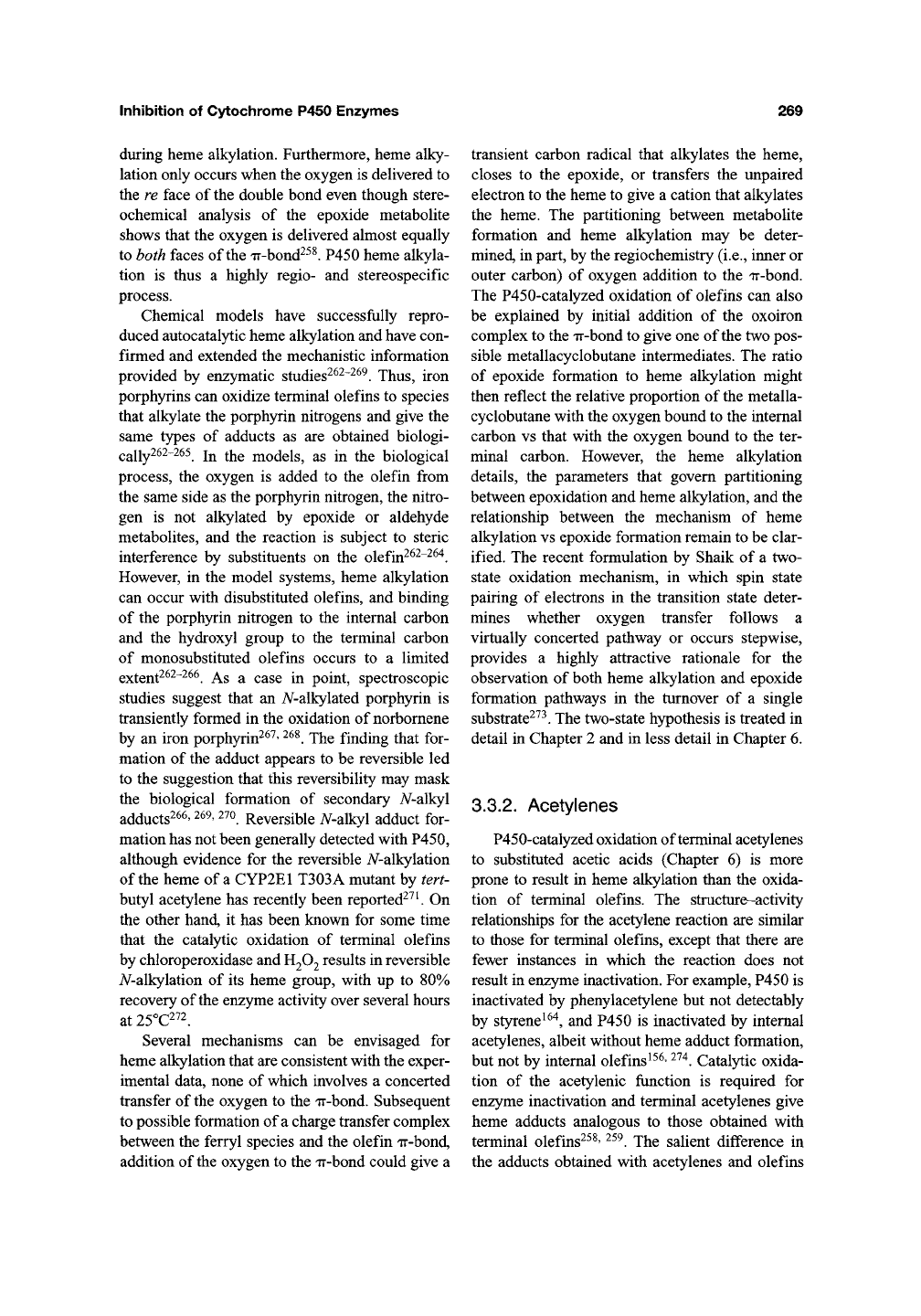
Inhibition of Cytoclirome P450 Enzymes
269
during heme alkylation. Furthermore, heme alky-
lation only occurs when the oxygen is delivered to
the re face of the double bond even though stere-
ochemical analysis of the epoxide metabolite
shows that the oxygen is delivered almost equally
to both faces of the 7r-bond^^^. P450 heme alkyla-
tion is thus a highly regio- and stereospecific
process.
Chemical models have successfully repro-
duced autocatalytic heme alkylation and have con-
firmed and extended the mechanistic information
provided by enzymatic studies^^^"^^^. Thus, iron
porphyrins can oxidize terminal olefins to species
that alkylate the porphyrin nitrogens and give the
same types of adducts as are obtained biologi-
^^jjy262-265 jj^
^^Q
models, as in the biological
process, the oxygen is added to the olefin from
the same side as the porphyrin nitrogen, the nitro-
gen is not alkylated by epoxide or aldehyde
metabolites, and the reaction is subject to steric
interference by substituents on the olefin^^^"^^"^.
However, in the model systems, heme alkylation
can occur with disubstituted olefins, and binding
of the porph3^in nitrogen to the internal carbon
and the hydroxyl group to the terminal carbon
of monosubstituted olefins occurs to a limited
extent^^^"^^^. As a case in point, spectroscopic
studies suggest that an A^-alkylated porphyrin is
transiently formed in the oxidation of norbornene
by an iron porphyrin^^^'
^^^.
The finding that for-
mation of the adduct appears to be reversible led
to the suggestion that this reversibility may mask
the biological formation of secondary iV-alkyl
adducts266,269,270 Reversible 7V-alkyl adduct for-
mation has not been generally detected with P450,
although evidence for the reversible A/-alkylation
of the heme of a CYP2E1 T303A mutant by tert-
butyl acetylene has recently been reported^^^ On
the other hand, it has been known for some time
that the catalytic oxidation of terminal olefins
by chloroperoxidase and
H2O2
results in reversible
iV-alkylation of its heme group, with up to 80%
recovery of the enzyme activity over several hours
at 25°C2'72.
Several mechanisms can be envisaged for
heme alkylation that are consistent with the exper-
imental data, none of which involves a concerted
transfer of the oxygen to the ir-bond. Subsequent
to possible formation of a charge transfer complex
between the ferryl species and the olefin ir-bond,
addition of
the
oxygen to the ir-bond could give a
transient carbon radical that alkylates the heme,
closes to the epoxide, or transfers the unpaired
electron to the heme to give a cation that alkylates
the heme. The partitioning between metabolite
formation and heme alkylation may be deter-
mined, in part, by the regiochemistry (i.e., inner or
outer carbon) of oxygen addition to the Tr-bond.
The P450-catalyzed oxidation of olefins can also
be explained by initial addition of the oxoiron
complex to the ir-bond to give one of the two pos-
sible metallacyclobutane intermediates. The ratio
of epoxide formation to heme alkylation might
then reflect the relative proportion of the metalla-
cyclobutane with the oxygen bound to the internal
carbon vs that with the oxygen bound to the ter-
minal carbon. However, the heme alkylation
details, the parameters that govern partitioning
between epoxidation and heme alkylation, and the
relationship between the mechanism of heme
alkylation vs epoxide formation remain to be clar-
ified. The recent formulation by Shaik of a two-
state oxidation mechanism, in which spin state
pairing of electrons in the transition state deter-
mines whether oxygen transfer follows a
virtually concerted pathway or occurs stepwise,
provides a highly attractive rationale for the
observation of both heme alkylation and epoxide
formation pathways in the turnover of a single
substrate^^^. The two-state hypothesis is treated in
detail in Chapter 2 and in less detail in Chapter 6.
3.3.2. Acetylenes
P450-catalyzed oxidation of terminal acetylenes
to substituted acetic acids (Chapter 6) is more
prone to result in heme alkylation than the oxida-
tion of terminal olefins. The structure-activity
relationships for the acetylene reaction are similar
to those for terminal olefins, except that there are
fewer instances in which the reaction does not
result in enzyme inactivation. For example, P450 is
inactivated by phenylacetylene but not detectably
by styrene^^"^, and P450 is inactivated by internal
acetylenes, albeit without heme adduct formation,
but not by internal olefins
^^^' ^^'^.
Catalytic oxida-
tion of the acetylenic function is required for
enzyme inactivation and terminal acetylenes give
heme adducts analogous to those obtained with
terminal olefins^^^' ^^^. The salient difference in
the adducts obtained with acetylenes and olefins
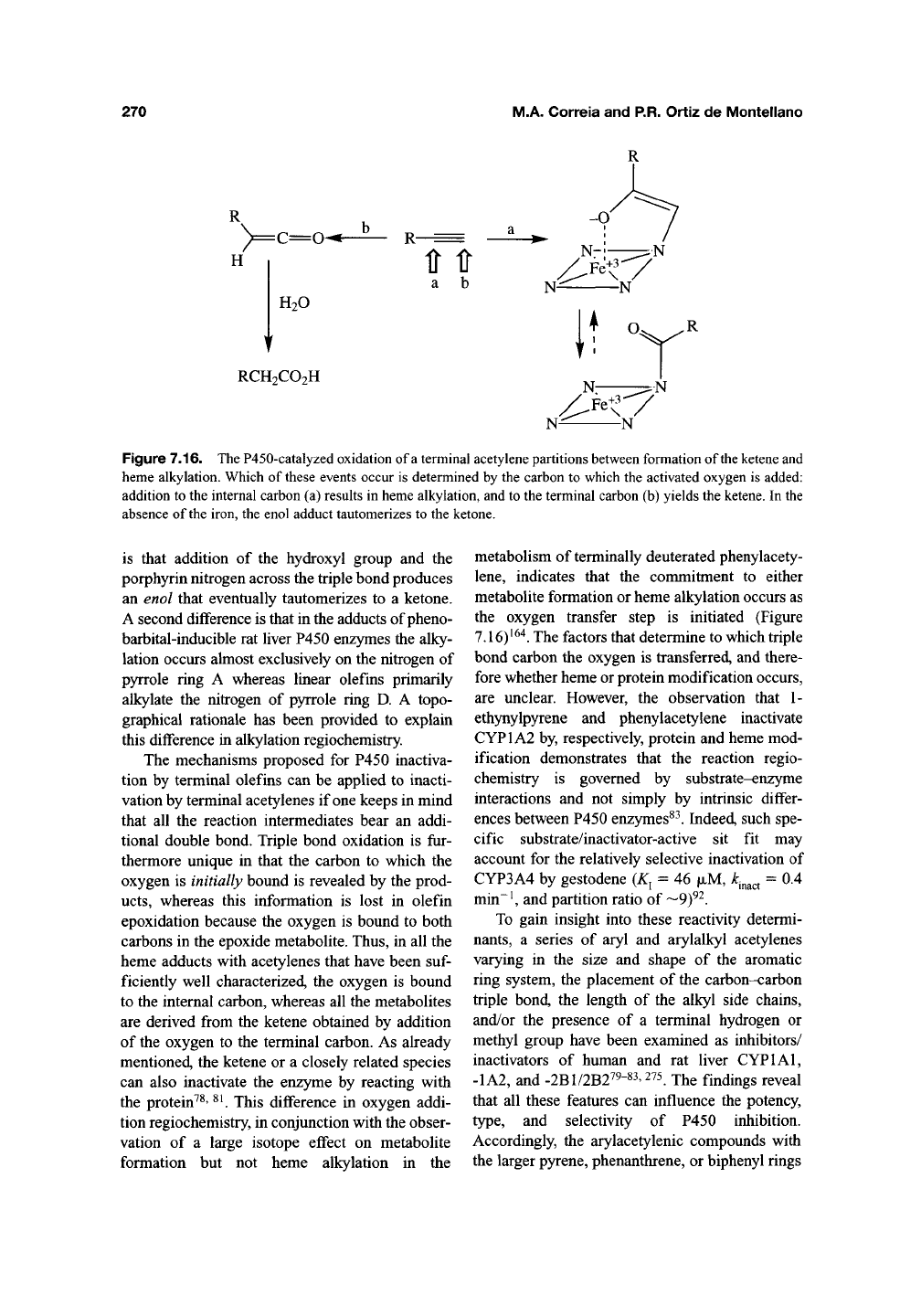
270 M.A. Correia and P.R. Ortiz de Montellano
R
R
y=c=o-
H
H2O
RCH2CO2H
Figure 7.16. The P450-catalyzed oxidation of
a
terminal acetylene partitions between formation of
the ketene
and
heme alkylation. Which of
these
events occur is determined by the carbon to which the activated oxygen is added:
addition to the internal carbon (a) results in heme alkylation, and to the terminal carbon (b) yields the ketene. In the
absence of the iron, the enol adduct tautomerizes to the ketone.
is that addition of the hydroxyl group and the
porphyrin nitrogen across the triple bond produces
an enol that eventually tautomerizes to a ketone.
A second difference is that in the adducts of pheno-
barbital-inducible rat liver P450
QnzymQS
the alky-
lation occurs almost exclusively on the nitrogen of
pyrrole ring A whereas linear olefins primarily
alkylate the nitrogen of pyrrole ring D. A topo-
graphical rationale has been provided to explain
this difference in alkylation regiochemistry.
The mechanisms proposed for P450 inactiva-
tion by terminal olefins can be applied to inacti-
vation by terminal acetylenes if one keeps in mind
that all the reaction intermediates bear an addi-
tional double bond. Triple bond oxidation is fur-
thermore unique in that the carbon to which the
oxygen is initially bound is revealed by the prod-
ucts,
whereas this information is lost in olefin
epoxidation because the oxygen is bound to both
carbons in the epoxide metabolite. Thus, in all the
heme adducts with acetylenes that have been
suf-
ficiently well characterized, the oxygen is bound
to the internal carbon, whereas all the metabolites
are derived from the ketene obtained by addition
of the oxygen to the terminal carbon. As already
mentioned, the ketene or a closely related species
can also inactivate the enzyme by reacting with
the protein^^' ^^ This difference in oxygen addi-
tion regiochemistry, in conjunction with the obser-
vation of a large isotope effect on metabolite
formation but not heme alkylation in the
metabolism of terminally deuterated phenylacety-
lene,
indicates that the commitment to either
metabolite formation or heme alkylation occurs as
the oxygen transfer step is initiated (Figure
7.16)^^"*. The factors that determine to which triple
bond carbon the oxygen is transferred, and there-
fore whether heme or protein modification occurs,
are unclear. However, the observation that 1-
ethynylpyrene and phenylacetylene inactivate
CYP1A2 by, respectively, protein and heme mod-
ification demonstrates that the reaction regio-
chemistry is governed by substrate-enzyme
interactions and not simply by intrinsic differ-
ences between P450 enzymes^^. Indeed, such spe-
cific substrate/inactivator-active sit fit may
account for the relatively selective inactivation of
CYP3A4 by gestodene
(K^
= 46 |xM,
k-^^^^
= 0.4
min~', and partition ratio of
~9)^^.
To gain insight into these reactivity determi-
nants,
a series of aryl and arylalkyl acetylenes
varying in the size and shape of the aromatic
ring system, the placement of the carbon-carbon
triple bond, the length of the alkyl side chains,
and/or the presence of a terminal hydrogen or
methyl group have been examined as inhibitors/
inactivators of human and rat liver CYPlAl,
-1A2,
and -2Bl/2B2^9-83,275 jhe findings reveal
that all these features can influence the potency,
type,
and selectivity of P450 inhibition.
Accordingly, the arylacetylenic compounds with
the larger
pyrcnQ,
phenanthrene, or biphenyl rings
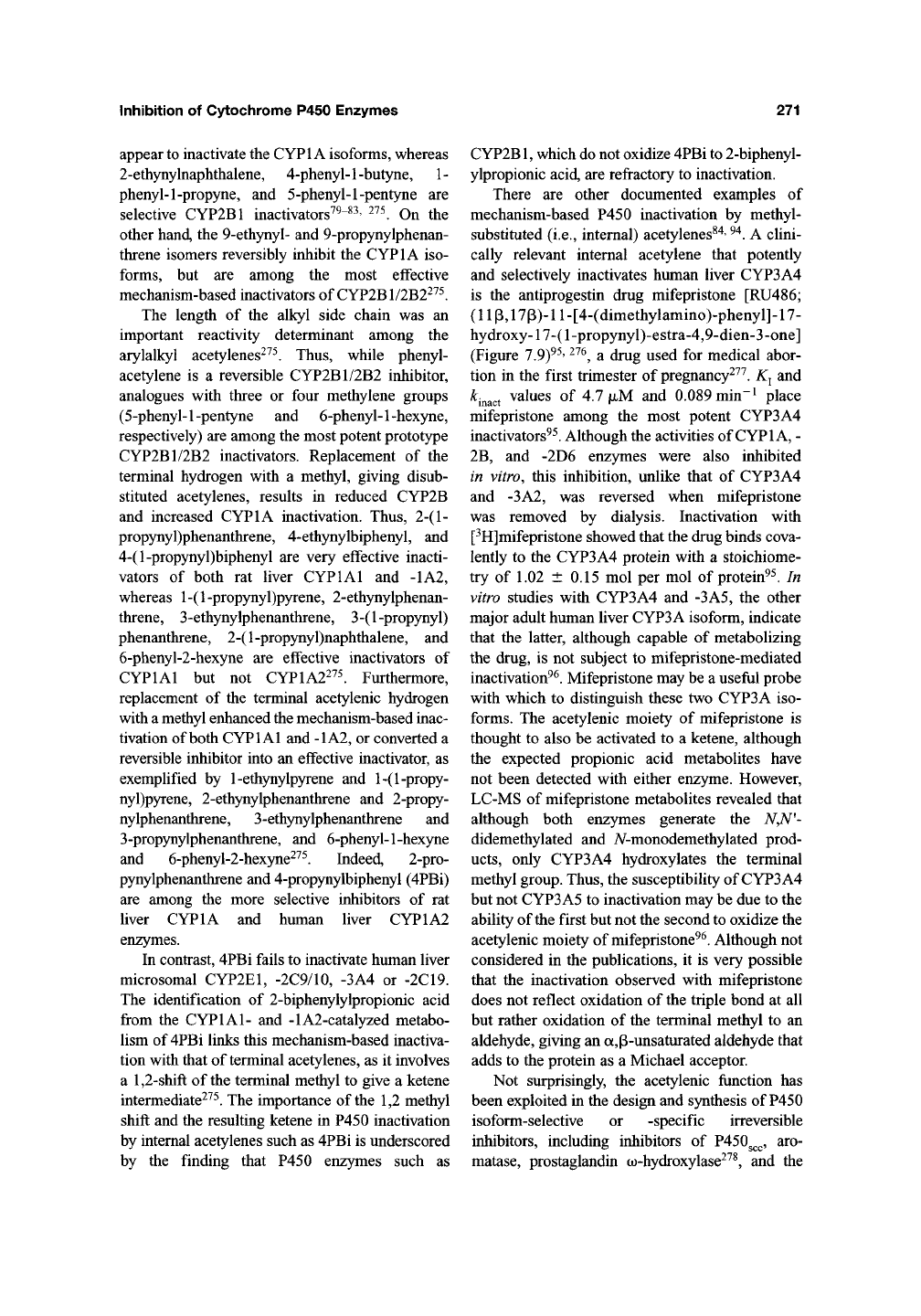
Inhibition
of
Cytochrome
P450
Enzymes
271
appear to inactivate the CYPl A isoforms, whereas
2-ethynylnaphthalene, 4-phenyl-l-butyne, 1-
phenyl-1-propyne, and 5-phenyl-l-pentyne are
selective CYP2B1 inactivators^^-^^' ^^^ On the
other hand, the 9-ethynyl- and 9-propynylphenan-
threne isomers reversibly inhibit the CYPl A iso-
forms,
but are among the most effective
mechanism-based inactivators of CYP2B1/2B22^^
The length of the alkyl side chain was an
important reactivity determinant among the
arylalkyl acetylenes^^^. Thus, while phenyl-
acetylene is a reversible CYP2B1/2B2 inhibitor,
analogues with three or four methylene groups
(5 -phenyl-1 -pentyne and 6-phenyl-1 -hexyne,
respectively) are among the most potent prototype
CYP2B1/2B2 inactivators. Replacement of the
terminal hydrogen with a methyl, giving disub-
stituted acetylenes, results in reduced CYP2B
and increased CYPl A inactivation. Thus, 2-(l-
propynyl)phenanthrene, 4-ethynylbiphenyl, and
4-(l-propynyl)biphenyl are very effective inacti-
vators of both rat liver CYPlAl and -1A2,
whereas l-(l-propynyl)pyrene, 2-ethynylphenan-
threne, 3-ethynylphenanthrene, 3-(l-propynyl)
phenanthrene, 2-(l-propynyl)naphthalene, and
6-phenyl-2-hexyne are effective inactivators of
CYPlAl but not CYP\A2^^\ Furthermore,
replacement of the terminal acetylenic hydrogen
with a methyl enhanced the mechanism-based inac-
tivation of both CYPlAl and -1A2, or converted a
reversible inhibitor into an effective inactivator, as
exemplified by 1-ethynylpyrene and l-(l-propy-
nyl)pyrene, 2-ethynylphenanthrene and 2-propy-
nylphenanthrene, 3-ethynylphenanthrene and
3-propynylphenanthrene, and 6-phenyl-1-hexyne
and 6-phenyl-2-hexyne^^^. Indeed, 2-pro-
pynylphenanthrene and 4-propynylbiphenyl (4PBi)
are among the more selective inhibitors of rat
liver CYPIA and human liver CYP1A2
enz3mies.
In contrast, 4PBi fails to inactivate human liver
microsomal CYP2E1, -2C9/10, -3A4 or -2C19.
The identification of 2-biphenylylpropionic acid
from the CYPlAl- and -lA2-catalyzed metabo-
lism of 4PBi links this mechanism-based inactiva-
tion with that of terminal acetylenes, as it involves
a
1,2-shift
of the terminal methyl to give a ketene
intermediate^^^. The importance of
the
1,2 methyl
shift and the resulting ketene in P450 inactivation
by internal acetylenes such as 4PBi is underscored
by the finding that P450 enzymes such as
CYP2B1,
which do not oxidize 4PBi to 2-biphenyl-
ylpropionic acid, are refractory to inactivation.
There are other documented examples of
mechanism-based P450 inactivation by methyl-
substituted (i.e., internal) acetylenes^"*'
^^.
A clini-
cally relevant internal acetylene that potently
and selectively inactivates human liver CYP3A4
is the antiprogestin drug mifepristone [RU486;
(lip,17P)-ll-[4-(dimethylamino)-phenyl]-17-
hydroxy-17-(
1
-propynyl)-estra-4,9-dien-3-one]
(Figure 7.9)^^' ^^^, a drug used for medical abor-
tion in the first trimester of pregnancy^^^. K^ and
^inact values of 4.7
JULM
and 0.089 min~^ place
mifepristone among the most potent CYP3A4
inactivators^^. Although the activities of CYPIA, -
2B,
and -2D6 enzymes were also inhibited
in vitro, this inhibition, unlike that of CYP3A4
and -3A2, was reversed when mifepristone
was removed by dialysis. Inactivation with
[^H]mifepristone showed that the drug binds cova-
lently to the CYP3A4 protein with a stoichiome-
try of 1.02 ± 0.15 mol per mol of protein^^. In
vitro studies with CYP3A4 and -3A5, the other
major adult human liver CYP3A isoform, indicate
that the latter, although capable of metabolizing
the drug, is not subject to mifepristone-mediated
inactivation^^. Mifepristone may be a usefiil probe
with which to distinguish these two CYP3A iso-
forms.
The acetylenic moiety of mifepristone is
thought to also be activated to a ketene, although
the expected propionic acid metabolites have
not been detected with either enzyme. However,
LC-MS of mifepristone metabolites revealed that
although both enzymes generate the
NJ\f'-
didemethylated and A^-monodemethylated prod-
ucts,
only CYP3A4 hydroxylates the terminal
methyl group. Thus, the susceptibility of CYP3A4
but not CYP3A5 to inactivation may be due to the
ability of the first but not the second to oxidize the
acetylenic moiety of mifepristone^^. Although not
considered in the publications, it is very possible
that the inactivation observed with mifepristone
does not reflect oxidation of the triple bond at all
but rather oxidation of the terminal methyl to an
aldehyde, giving an a,p-unsaturated aldehyde that
adds to the protein as a Michael acceptor.
Not surprisingly, the acetylenic fimction has
been exploited in the design and synthesis of P450
isoform-selective or -specific irreversible
inhibitors, including inhibitors of P450g^^, aro-
matase, prostaglandin w-hydroxylase-^^^, and the
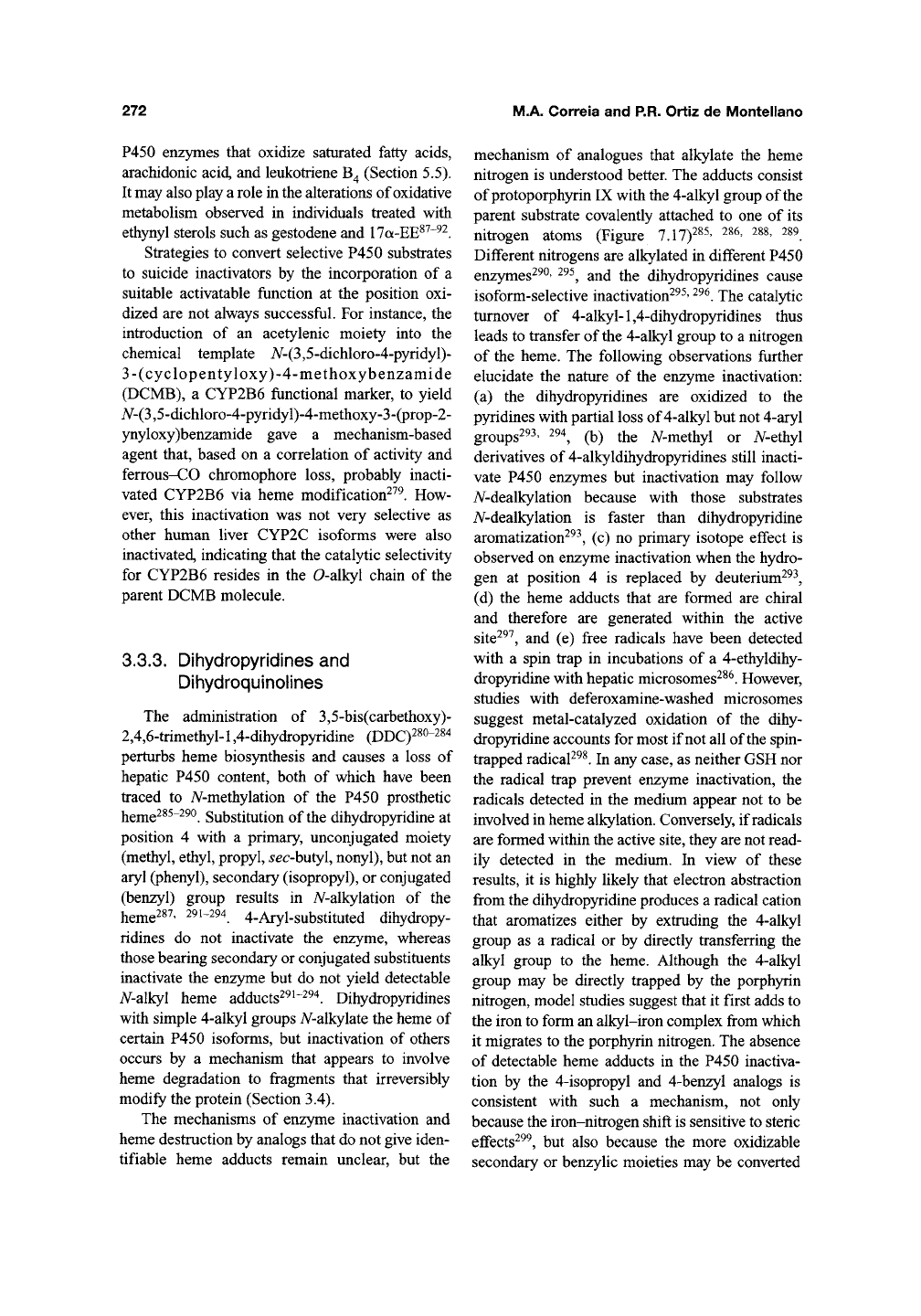
272
M.A. Correia and P.R. Ortiz de Montellano
P450 enzymes that oxidize saturated fatty acids,
arachidonic acid, and leukotriene B^ (Section 5.5).
It may also play a role in the alterations of oxidative
metabolism observed in individuals treated with
ethynyl sterols such as gestodene and 17a-EE^^~^^.
Strategies to convert selective P450 substrates
to suicide inactivators by the incorporation of a
suitable activatable function at the position oxi-
dized are not always successful. For instance, the
introduction of an acetylenic moiety into the
chemical template A/-(3,5-dichloro-4-pyridyl)-
3-(cyclopentyloxy)-4-methoxybenzamide
(DCMB), a CYP2B6 functional marker, to yield
A^-(3,5-dichloro-4-pyridyl)-4-methoxy-3-(prop-2-
ynyloxy)benzamide gave a mechanism-based
agent that, based on a correlation of activity and
ferrous-CO chromophore loss, probably inacti-
vated CYP2B6 via heme modification^^^. How-
ever, this inactivation was not very selective as
other human liver CYP2C isoforms were also
inactivated, indicating that the catalytic selectivity
for CYP2B6 resides in the 0-alkyl chain of the
parent DCMB molecule.
3.3.3. Dihydropyridines and
Dihydroquinolines
The administration of 3,5-bis(carbethoxy)-
2,4,6-trimethyl-1,4-dihydropyridine (DDC)280-284
perturbs heme biosynthesis and causes a loss of
hepatic P450 content, both of which have been
traced to iV-methylation of the P450 prosthetic
heme^^^~2^^.
Substitution of
the
dihydropyridine at
position 4 with a primary, unconjugated moiety
(methyl, ethyl, propyl, sec-buty\, nonyl), but not an
aryl (phenyl), secondary (isopropyl), or conjugated
(benzyl) group results in A^-alkylation of the
heme^^^' 291-294 4-Aryl-substituted dihydropy-
ridines do not inactivate the enzyme, whereas
those bearing secondary or conjugated substituents
inactivate the
QYoyme
but do not yield detectable
A^-alkyl heme adducts^^^"^^"^. Dihydropyridines
with simple 4-alkyl groups 7V-alkylate the heme of
certain P450 isoforms, but inactivation of others
occurs by a mechanism that appears to involve
heme degradation to fragments that irreversibly
modify the protein (Section 3.4).
The mechanisms of enzyme inactivation and
heme destruction by analogs that do not give iden-
tifiable heme adducts remain unclear, but the
mechanism of analogues that alkylate the heme
nitrogen is understood better. The adducts consist
of protoporphyrin IX with the 4-alkyl group of the
parent substrate covalently attached to one of its
nitrogen atoms (Figure 7.17)^^^' ^^^' 2^^' ^89
Different nitrogens are alkylated in different P450
enzymes-^^^' ^^^, and the dihydropyridines cause
isoform-selective inactivation^^^'
^^^.
The catalytic
turnover of 4-alkyl-1,4-dihydropyridines thus
leads to transfer of the 4-alkyl group to a nitrogen
of the heme. The following observations further
elucidate the nature of the enzyme inactivation:
(a) the dihydropyridines are oxidized to the
pyridines with partial loss of 4-alkyl but not 4-aryl
groups^^^' 2^^, (b) the A/-methyl or A^-ethyl
derivatives of 4-alkyldihydropyridines still inacti-
vate P450 enzymes but inactivation may follow
A^-dealkylation because with those substrates
A^-dealkylation is faster than dihydropyridine
aromatization^^^, (c) no primary isotope effect is
observed on enzyme inactivation when the hydro-
gen at position 4 is replaced by deuterium^^^,
(d) the heme adducts that are formed are chiral
and therefore are generated within the active
site^^^,
and (e) free radicals have been detected
with a spin trap in incubations of a 4-ethyldihy-
dropyridine with hepatic microsomes^^^. However,
studies with deferoxamine-washed microsomes
suggest metal-catalyzed oxidation of the dihy-
dropyridine accounts for most if not all of the spin-
trapped radicaF^^. In any case, as neither GSH nor
the radical trap prevent enzyme inactivation, the
radicals detected in the medium appear not to be
involved in heme alkylation. Conversely, if radicals
are formed within the active site, they are not read-
ily detected in the medium. In view of these
results, it is highly likely that electron abstraction
from the dihydropyridine produces a radical cation
that aromatizes either by extruding the 4-alkyl
group as a radical or by directly transferring the
alkyl group to the heme. Although the 4-alkyl
group may be directly trapped by the porphyrin
nitrogen, model studies suggest that it first adds to
the iron to form an alkyl-iron complex from which
it migrates to the porphyrin nitrogen. The absence
of detectable heme adducts in the P450 inactiva-
tion by the 4-isopropyl and 4-benzyl analogs is
consistent with such a mechanism, not only
because the iron-nitrogen shifl is sensitive to steric
efifects^^^, but also because the more oxidizable
secondary or benzylic moieties may be converted

Inhibition of Cytochrome P450 Enzymes
273
H R
H R
H(R)
^t^2C^jyC/C02Et Et02C^>C/C02Et Et02C^^X^C02Et
11^
XI —^ XT
CUf N "CH3
H
cnf N "CH3
H
N CH3
CH3 (R)
Figure 7.17. Oxidation of 4-alkyl-l,4-dihydropyridines and 2,2-dialkyl-l,2-dihydroquinolines is proposed to
yield cation radical intermediates that aromatize by either losing a second electron and a proton or an alkyl radical
that adds to a nitrogen of the prosthetic heme group.
to the corresponding cations by electron loss to the
iron in preference to undergoing the oxidative
iron-nitrogen shift.
The precedent set by the P450-catalyzed oxi-
dation of dihydropyridines to radical cations that
aromatize by radical extrusion has led to the
observation of comparable processes in related
structures. Thus, 2,2-dialkyl-l,2-dihydroquino-
lines are also oxidized by P450 enzymes to
species that iV-alkylate the heme and inactivate
the enzymes. In these reactions, the 2-alkyl
substituent of the dihydroquinoline is bound to
a nitrogen of protoporphyrin IX, presumably by
a mechanism similar to that proposed for the
4-alkyldihydropyridines (Figure 7.17)^^^.
3.3.4. Alkyl- and Arylhydrazines and
Hydrazones
The P450-destructive mechanism of
phenelzine, an alkylhydrazine, is relatively well
defined. It causes an approximately equimolar
loss of enzyme and heme when incubated with
hepatic microsomes'^^ and these losses are
accompanied by the generation of a heme adduct
identified as A/-(2-phenylethyl)protoporphyrin IX
(Figure 7.18)'^^. The generation of products
in a microsomal system that implicate the 2-
phenylethyl radical as a central MI suggests a role
for the 2-phenylethyl radical in this enzyme inac-
tivation'^'. Spin-trapping experiments confirm
that the 2-phenylethyl radical is generated in the
incubations but the bulk of
the
radical that is spin
trapped is formed by transition metal, rather than
P450-catalyzed reactions'^^'
^^^.
It appears from
these results that phenelzine is converted to the 2-
phenylethyl radical within the P450 active site
where it is captured by the heme to give the
iV-(2-phenylethyl) adduct (Figure 7.18). The 2-
phenylethyl radical could react directly with the
porphyrin nitrogens, but by analogy to the reactions
of hemoproteins with arylhydrazines (see below) it
is likely that the alkyl radical is trapped by reaction
with the heme iron to give an unstable alkyl-
iron complex that subsequently rearranges to the
isolated A/-alkyl heme adduct.
A complex with an absorbance maximum
at 480 nm is generated in the reaction of P450
with phenylhydrazines and A^-phenylhydrazones.
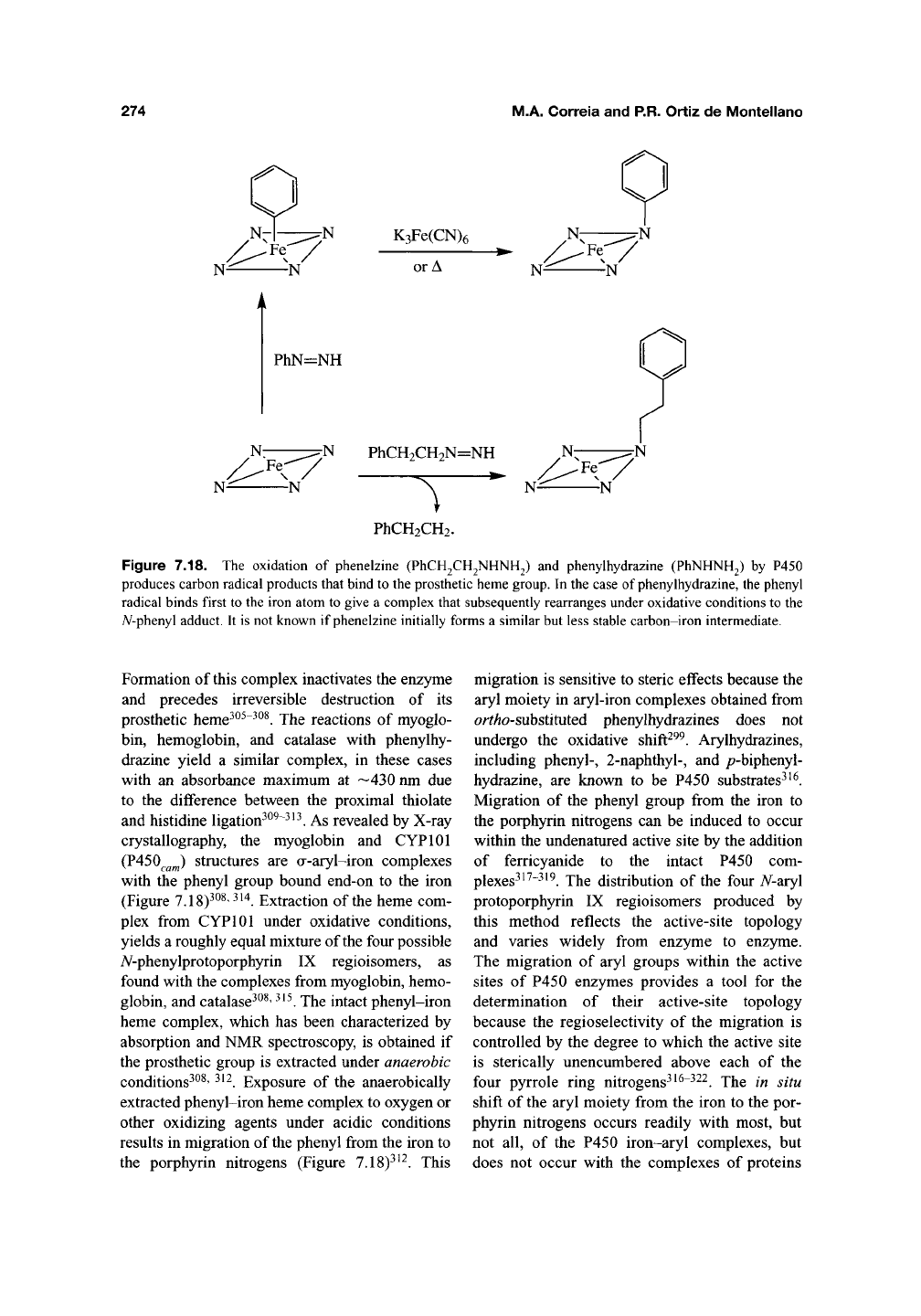
274
M.A. Correia and P.R. Ortiz de Montellano
K3Fe(CN)6
or
A
PhN=NH
N-
,Fe-
=;N PhCH2CH2N=:NH
N-
-N
PhCH2CH2.
Figure 7.18. The oxidation of phenelzine (PhCH2CH2NHNH2) and phenylhydrazine (PhNHNH2) by P450
produces carbon radical products that bind to the prosthetic heme group. In the case of phenylhydrazine, the phenyl
radical binds first to the iron atom to give a complex that subsequently rearranges under oxidative conditions to the
yV-phenyl adduct. It is not known if phenelzine initially forms a similar but less stable carbon-iron intermediate.
Formation of this complex inactivates the enzyme
and precedes irreversible destruction of its
prosthetic heme^^^"^^^. The reactions of myoglo-
bin, hemoglobin, and catalase with phenylhy-
drazine yield a similar complex, in these cases
with an absorbance maximum at —430 nm due
to the difference between the proximal thiolate
and histidine ligation^^^~^^^. As revealed by X-ray
crystallography, the myoglobin and CYPlOl
(P450^^^) structures are a-aryl-iron complexes
with the phenyl group bound end-on to the iron
(Figure 7.18)^^^' ^'^. Extraction of the heme com-
plex from CYPlOl under oxidative conditions,
yields a roughly equal mixture of the four possible
A^-phenylprotoporphyrin IX regioisomers, as
found with the complexes from myoglobin, hemo-
globin, and catalase^^^'
^^^.
The intact phenyl-iron
heme complex, which has been characterized by
absorption and NMR spectroscopy, is obtained if
the prosthetic group is extracted under anaerobic
conditions^^^' ^^^. Exposure of the anaerobically
extracted phenyl-iron heme complex to oxygen or
other oxidizing agents under acidic conditions
results in migration of
the
phenyl from the iron to
the porphyrin nitrogens (Figure 7.18)^^^. This
migration is sensitive to steric effects because the
aryl moiety in aryl-iron complexes obtained from
ortho-suhsXitaiQd phenylhydrazines does not
undergo the oxidative shift^^^. Arylhydrazines,
including phenyl-, 2-naphthyl-, and /7-biphenyl-
hydrazine, are known to be P450 substrates^^^.
Migration of the phenyl group from the iron to
the porphyrin nitrogens can be induced to occur
within the undenatured active site by the addition
of ferricyanide to the intact P450 com-
plexes^'^~^^^. The distribution of the four iV-aryl
protoporphyrin IX regioisomers produced by
this method reflects the active-site topology
and varies widely from enzyme to enzyme.
The migration of aryl groups within the active
sites of P450 enzymes provides a tool for the
determination of their active-site topology
because the regioselectivity of the migration is
controlled by the degree to which the active site
is sterically unencumbered above each of the
four pyrrole ring nitrogens^ ^^~^^^. The in situ
shift of the aryl moiety from the iron to the por-
phyrin nitrogens occurs readily with most, but
not all, of the P450 iron-aryl complexes, but
does not occur with the complexes of proteins
